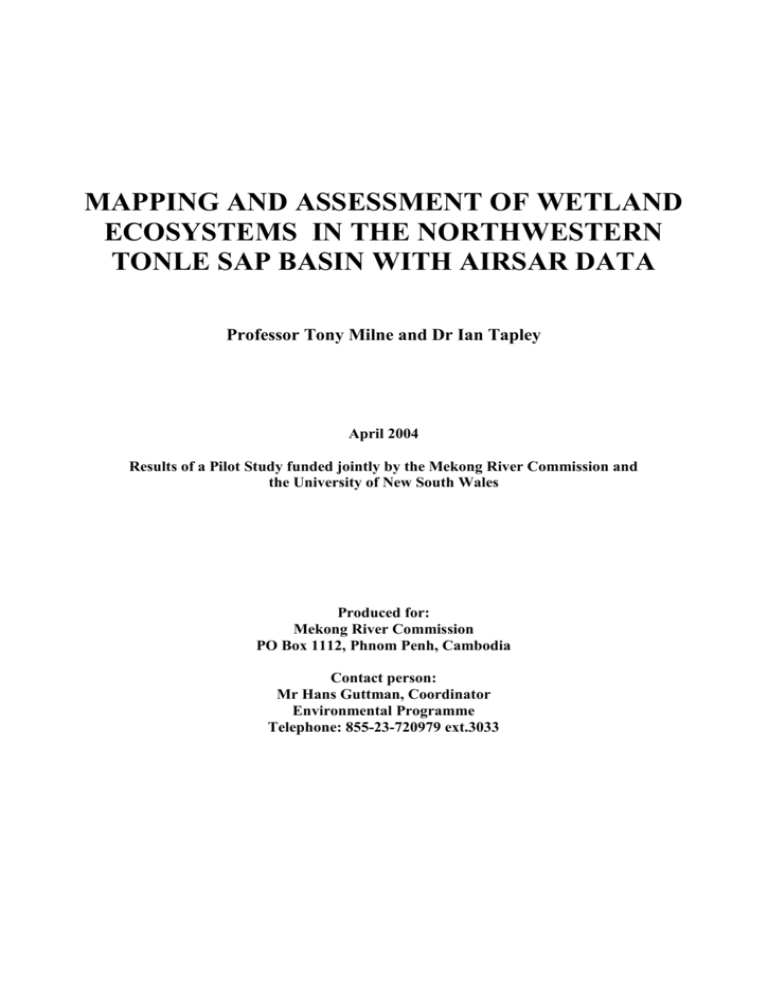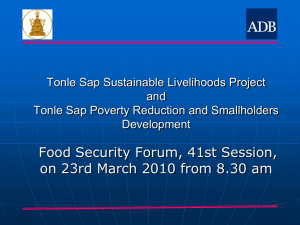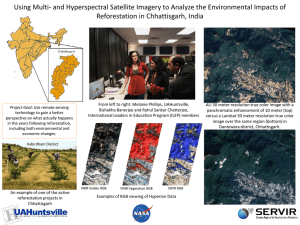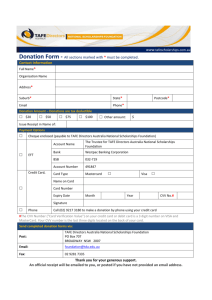mapping and assessment of wetland ecosystems in the
advertisement

MAPPING AND ASSESSMENT OF WETLAND ECOSYSTEMS IN THE NORTHWESTERN TONLE SAP BASIN WITH AIRSAR DATA Professor Tony Milne and Dr Ian Tapley April 2004 Results of a Pilot Study funded jointly by the Mekong River Commission and the University of New South Wales Produced for: Mekong River Commission PO Box 1112, Phnom Penh, Cambodia Contact person: Mr Hans Guttman, Coordinator Environmental Programme Telephone: 855-23-720979 ext.3033 Table of Contents List of figures .................................................................................................................................. iii List of Tables .................................................................................................................................. vi 1. SUMMARY ........................................................................................................................... 1 2. 2.1 2.2 2.3 2.4 2.5 PROJECT BACKGROUND ............................................................................................... 1 Introduction ............................................................................................................................ 1 Issues and problems addressed .............................................................................................. 2 Objectives ............................................................................................................................... 3 Linkage to MRC core program .............................................................................................. 3 Biosphere reserve ................................................................................................................... 5 3. 3.1 3.2 3.3 3.4 STUDY SITE DESCRIPTION Hydrology .............................................................................................................................. 6 Vegetation and fauna .............................................................................................................. 6 Human occupance ................................................................................................................... 7 Basin-wide linkages ................................................................................................................ 7 4. 4.1 4.2 4.3 4.4 REMOTE SENSING AND RADAR Radar background ................................................................................................................. 10 Operational satellite systems ................................................................................................. 11 AIRSAR – Airborne Synthetic Aperture Radar ................................................................... 13 Current state of remotely sensed data ................................................................................... 14 4.4.1 ASTER .................................................................................................................... 14 4.4.2 MODIS ................................................................................................................... 14 5. 5.1 5.2 5.3 5.4 PROJECT DESIGN AIRSAR data collection ....................................................................................................... 16 Field program ....................................................................................................................... 16 Project personnel ................................................................................................................... 16 Project organisation and work plan ...................................................................................... 16 6. 6.1 DATA PROCESSING STEPS FOR WETLAND CLASSIFICATION Pre-processing AIRSAR data ............................................................................................... 26 6.1.1 Radiometric restoration .......................................................................................... 26 6.1.2 Geometric restoration ............................................................................................. 26 Band Selection ...................................................................................................................... 26 Discriminant analysis ............................................................................................................ 28 Segmentation and classification ........................................................................................... 30 6.4.1 Filtering ................................................................................................................. 31 6.4.2 Segmentation ........................................................................................................... 31 6.4.3 Clustering ............................................................................................................... 32 6.4.4 Classification ......................................................................................................... 32 Summary of classification methodology............................................................................... 32 6.2 6.3 6.4 6.5 7. WETLAND CLASSIFICATION 7.1 Introduction ........................................................................................................................... 57 7.2 Classification and class definitions ...................................................................................... 57 7.3 Description of major classes ................................................................................................. 59 7.3.1 Flooded forest-trees ............................................................................................... 59 i 7.4 7.5 7.6 7.3.2 Shrublands ............................................................................................................. 60 7.3.3 Macrophytes ........................................................................................................... 61 7.3.4 Flooded fields and grasslands ................................................................................ 61 7.3.5 Irrigated ricefields .................................................................................................. 62 Elevation and vegetation distribution ................................................................................... 62 Discussion ............................................................................................................................. 63 Summary ............................................................................................................................... 64 8. COMPARISON OF RADAR AND OPTICAL DATA OVER TSGL WETLANDS.... 82 9. 9.1 9.2 9.3 FLOOD MAPPING, SEPTEMBER 2000 AIRSAR flood map ............................................................................................................... 93 DEM flood modelling ........................................................................................................... 93 ASTER and MODIS coverage .............................................................................................. 94 10. 10.1 10.2 10.3 10.4 CHANGE ANALYSIS USING JERS RADAR DATA Introduction ......................................................................................................................... 105 JERS change detection ........................................................................................................ 105 Sub-area case studies .......................................................................................................... 108 Conclusions ........................................................................................................................ 109 11. GIS DATABASE ............................................................................................................... 125 12. 12.1 12.2 CONCLUSIONS AND RECOMMENDATIONS .......................................................... 125 Conclusions ......................................................................................................................... 125 Recommendations ............................................................................................................... 127 13. ACKNOWLEDGEMENTS ............................................................................................. 127 14. BIBLIOGRAPHY AND PUBLICATIONS .................................................................... 128 ii List of Figures 3.1: 4.1: 5.1: 5.2: 5.3: 5.4: 5.5: 5.6: 5.7: 5.8: 5.9: 6.1: 6.2: 6.3: 6.4: 6.5: 6.6: 6.7: 6.8: 6.9: 6.10: 6.11: 6.12: 6.13: 6.14: 6.15: 6.16: 6.17: 6.18: 6.19: 6.20: 6:21: 6.22: 6.23: Location of Lake Tonle Sap and wetland study site ............................................................................. 9 Main backscattering mechanisms and types of backscatter prevalent in wetland environments ....... 15 A mosaic of simulated coverage of the TOPSAR flight-lines ............................................................ 18 Location and dimensions of the AIRSAR flightlines over Angkor and Tonle Sap wetlands ............ 18 ASTER coverage (Bands 2:3:1 RGB) of wetland site adjacent to Lake Tonle Sap, with the locations of AIRSAR field sites discussed in this study..................................................................... 19 Macrophytes floating on open water and along waterways within shrublands. ................................. 20 Closed canopy forest trees and open canopy forest trees with patches of shrubland and open water .......................................................................................................................................... 21 Inundated forest and shrublands within the Preak Toal Reserve adjacent to Lake Tonle Sap ........... 22 Dense shrubland with open areas of macrophytes.............................................................................. 23 Grasslands, with regular patches of low open shrublands, occupying former ricefields along the northern edge of wetlands............................................................................................................. 24 Ricefields and grasslands flooded in September 2000 when the AIRSAR data were collected ........ 25 Histograms for the 7 bands of original AIRSAR data, and basic statistics for the original and adaptive filtered data.................................................................................................................... 34 Adaptive filtering of single-band AIRSAR data ................................................................................ 35 RGB colour composite images of AIRSAR bands Cvv/Lvv/Pvv before and after adaptive filtering to suppress speckle and “noise” in the data............................................................ 36 Mosaic of four AIRSAR flight-lines, Angkor 20-1, 20-2, 20-3 and 20-4 displayed as an RGB colour composite of bands Cvv/Lvv/Pvv ......................................................................... 37 Greytone images of the seven AIRSAR bands Cvv, Lhh, Lhv, Lvv, Phh, Phv and Pvv following correction for speckle and cross-track variation in antenna pattern............................ 38 Flightline 20-3 in two halves displayed as Cvv/Lvv/Pvv in RGB showing the location of training classes for Canonical Variate and All-bands Subset Analyses of the six bands of AIRSAR data ...................................................................................................... 39 Mean 6-band AIRSAR spectra for a 10x10 pixel-line area (50x50 m) of the field wetland sites located in Flightline Angkor 20-3 ........................................................................ 40 RGB composite of flight-line Angkor 20-3, displayed as Cvv/Lhv/Pvv............................................ 41 Six vector images derived from CVA of AIRSAR data and a summary of canonical variate analysis ................................................................................................................... 42 Canonical variate plots of the mean values for each wetland class .................................................... 43 Flightline 20-3 – composite image in two halves of canonical vectors 2:1:3 as RGB A comparison between a RGB composite image of AIRSAR bands Cvv/Lhv/Pvv and CVA image of canonical vectors 2:3:1 demonstrates the benefits of the CVA techniquefor highlighting regions of flooded rice, irrigated and rain-fed rice, high soil moisture and areas of habitation .................................................................................................. 45 RGB composite image of AIRSAR bands Cvv/Lhv/Pvv and CVA image of canonical vectors 2:3:1 ....................................................................................................................... 46 Forest trees, drowned shrubland and floodwaters, and macrophytes contrast strongly in both the RGB composite image of AIRSAR bands and CVA image ............................................ 47 Grasslands, forest trees, shrubland and open water, and patches of floodwater within open forest are readily identified in both the AIRSAR and CVA images .......................................... 48 Flightline 20-3 – colour composite image of AIRSAR bands Cvv/Lhv/Pvv (RGB) showing the position of segmented images examined in Figures 6.17 and 6.18 ................................ 49 Flightline 20-3, subarea #1 - segmented images for six bands of AIRSAR data and radar backscatter profiles ................................................................................................................... 50 Flightline 20-3, subarea #2 - segmented images for six bands of AIRSAR data and radar backscatter profiles .................................................................................................................... 51 Forest trees, open and closed canopy, field site #13 - processing steps to determine final classification ....................................................................................................................................... 52 Inundated shrubland, field site #4 - processing steps to determine final classification ...................... 53 Macrophyte, field site #2 - processing steps to determine final classification ................................... 54 Macrophytes, field site #9 - processing steps to determine final classification.................................. 55 Site 15 – Grassland, field site #15 - processing steps to determine final classification ..................... 56 iii 7.1: 7.2: 7.3: 7.4: 7.5: 7.6: 7.7: 7.8: 7.9: 7.10: 7.11: 7.12: 7.13: 7.14: 7.15: 8.1: 8.2: 8.3: 8.4: 8.5: 8.6: 8.7: 8.8: Iso-data classification of segmented AIRSAR Cvv/Lhv/Pvv data ..................................................... 65 Legend of 13 landcover classes derived from an Iso-data classification of AIRSAR bands Cvv/Lhv/Pvv, shown enlarged opposite as upper and lower halves of Flightline 20-3 ........... 66 Comparison between RGB composite image of bands Cvv/Lhv/Pvv and an iso-data classification of the segmented data for these bands highlighting the distribution of open water, grasslands and forest tree classes................................................................................ 68 Comparison between RGB composite image of bands Cvv/Lhv/Pvv and an iso-data classification of the segmented data for these bands highlighting the distribution of macrophytes and forest tree classes .................................................................................................... 69 Comparison between RGB composite image of bands Cvv/Lhv/Pvv and an iso-data classification of the segmented data for these bands highlighting the distribution of predominantly shrubland and forest tree classes ................................................................................ 70 Comparison between RGB composite image of bands Cvv/Lhv/Pvv and an iso-data classification of the segmented data highlighting the distribution of floodwater, macrophytes and forest trees .............................................................................................................. 71 Comparison between RGB composite image of bands Cvv/Lhv/Pvv and an iso-data classification of the segmented data highlighting the distribution of floodwaters, flooded shrubland, grassland and macrophytes with minor forest tree classes .................................. 72 Comparison between RGB composite image of bands Cvv/Lhv/Pvv and an iso-data classification of the segmented data highlighting the distribution of flooded ricefields that have been incorrectly classified as shrubland.............................................................................. 73 Legend landcover superclasses, derived from an iso-data classification of AIRSAR bands Cvv/Lhv/Pvv and shown opposite as upper and lower halves of Flightline 20-3 .................... 74 Wetland study site, western Lake Tonle Sap - 1 m interval height contours derived from JICA SPOT DEM overlaid on a colour-composite image of ASTER bands 2:1:3 displayed as RGB, respectively .......................................................................................................... 76 Wetland study site, western Lake Tonle Sap - 1 m interval height contours derived from JICA SPOT DEM overlaid on a colour-composite image of MODIS bands 2:1:2 displayed as RGB, respectively .......................................................................................................... 77 1 m height contours derived from JICA DEM, overlaid on RGB mosaic image of AIRSAR bands Cvv/Lhv/Pvv for lines 20-1, 20-2, 20-3 and (upper section) 20-4 ........................... 78 1 m height contours derived from JICA DEM, overlaid on the shrubland superclass for line 20-3 and shown in upper- and lower-half images ....................................................................... 79 1 m height contours derived from JICA DEM, overlaid on the macrophyte superclass for line 20-3 and shown in upper- and lower-half images .................................................................. 80 1 m height contours derived from JICA DEM, overlaid on the forest trees superclass for line 20-3 and shown in upper- and lower-half images .................................................................. 81 Comparison of optical ASTER image recorded in January 2002 of shrubland region and AIRSAR data recorded in September 2000 during a period of high flood .................................. 84 Aerial views captured in January 2002 of dense shrubland, cleared areas within shrubland with a macrophyte cover, and former cropping areas comprising grassland and invading shrubs................................................................................................................................... 85 An open shrubland adjacent to the Steng Sangkae, with areas of macrophytes and inundated shrublands can be readily identified in the AIRSAR image whereas they are very indistinct in the ASTER image ..................................................................................... 86 The presence of high floodwaters within the inundated shrubland in the September AIRSAR image permits a more accurate delineation of this wetland class than with the January ASTER scene .......................................................................................................... 87 Comparison of AIRSAR and ASTER data of grassland and open forest regions in vicinity of Sites 13, 14 and 15 ......................................................................................................................... 88 Aerial views of open forest along a river channel and grasslands flooded during the wet season when the AIRSAR data were acquired ................................................................................... 89 Large circular area of macrophyte with local shrubs and patches of open water are readily mapped in both the AIRSAR and ASTER images although the variable cover within the macrophytes is not as obvious in the ASTER scene ......................................................... 90 Closed canopy forest typified by Site 12, has a more consistent signature in the AIRSAR scene than the ASTER image owing to the strong canopy backscatter amplified iv 8.9: 9.1: 9.2: 9.3: 9.4: 9.5: 9.6: 9.7: 9.8: 9.9: 9.10: 10.1: 10.2: 10.3: 10.4: 10.5: 10.6: 10.7: 10.8: 10.9: 10.10: 10.11: 10.12: 10.13: 10.14: 10.15: by the underlying floodwaters ............................................................................................................ 91 West of Phnom Khrom and along the shore of Lake Tonle Sap the AIRSAR scene shows the shrublands in September 2000 were mostly flooded with occasional areas of macrophyte and broad zones of dense, mature trees fringing the lake edge. The macrophytes and fringing forest are equally apparent in the ASTER scene recorded in January 2002 ....................................... 92 A mosaic of eight flightlines of AIRSAR Cvv data depicting the extent of flooding beyond Lake Tonle Sap on 20th September 2000. Greytone areas within the flooded zone are flooded shrublands and forest trees, and macrophytes on the surface ............................................................. 95 Comparison of AIRSAR bands Cvv, Lhh and Lhv for defining variations in soil moisture in vicinity of West Baray, the flood water boundary, and presence of aquatic vegetation communities within the wetlands north of Lake Tonle Sap ............................................................... 96 12 m flood level in vicinity of the West Baray and Siem Reap as derived from a mosaic of TOPSAR DEM data acquired simultaneously with the Cvv data ...................................................... 97 3D model with 25x vertical exaggeration, and height-contour model of Tonle Sap Basin, derived from JICA SPOT DEM ......................................................................................................... 98 Height contour model of wetland study region adjacent to north-western edge of Lake Tonle Sap derived from JICA DEM in Figure 9.4........................................................................................ 99 A sequence of flood levels modelled from JICA SPOT DEM commencing at 2m and extending to 13m in 1m intervals ..................................................................................................... 100 A comparison of a wet-season AIRSAR Cvv and dry-season ASTER images west of Angkor ...... 101 A comparison of a wet-season AIRSAR Cvv and dry-season Terra-ASTER in vicinity of Phnom Khrom, north of Lake Tonle Sap ..................................................................................... 102 A time sequence of ASTER imagery centred on the hill Phnom Khrom, highlighting the extent and recession of floodwaters beyond the northern edge of Lake Tonle Sap ......................... 103 A time series of Terra-MODIS images showing the dry-wet-dry season cycle in vicinity of Lake Tonle Sap ............................................................................................................................ 104 Multi-date, grey-tone JERS-1 SAR images of Tonle Sap wetlands highlighting the variability in radar backscatter in response to an increase in surface run-off from local river systems and Lake Tonle Sap .......................................................................................... 110 Histograms and statistics for January, April and August, JERS SAR datasets. ............................... 111 Band Difference image and Change Detection for JERS-1 radar data from January and April 1997 .................................................................................................................................. 112 Band Difference image and Change Detection for JERS-1 radar data collected in April and August 1997 ............................................................................................................................... 113 Colour composite image of registered JERS-1 radar data for January, April and August 1997, displayed as RGB, respectively ................................................................................. 114 Greytone JERS-1 radar image of wetlands region collected on 15th September 1992 ..................... 115 Area 1 on Figure 10.5 – grey-tone JERS-1 radar images for January, April and August 1997, and a colour-composite image of January: April: August displayed as RGB, respectively ............. 116 Ground and aerial photographs of principal wetland communities within Area 1 .......................... 117 Area 2 on Figure 10.5 – greytone JERS-1 radar images for January, April and August 1997, and a colour-composite image of January: April: August displayed as RGB, respectively ............. 118 Wetlands within Area 2. The shrubland upslope of the recessional rice (foreground) is a collector site of water stored in preparation for release onto the ricefields ...................................... 119 Area 3 on Figure 10.5 – grey-tone JERS-1 radar images for January, April and August 1997, and a colour-composite image of January: April: August displayed as RGB, respectively ............. 120 Area 4 on Figure 10.5 – grey-tone JERS-1 radar images for January, April and August 1997, and a colour-composite image of January: April: August displayed as RGB, respectively, showing the location of sample sites within the inundated shrubland (I) at the western edge of Lake Tonle Sap .................................................................................................................... 121 A comparison of histograms for three dates of JERS-1 SAR data in 1997 for training sites representing two cover classes within the wetlands - inundated shrubland located at the western end of Lake Tonle Sap, and closed forest within the wetlands ................................. 122 Spectra and statistical information for January, April and August 1997, for training classes within the inundated shrubland located at the western end of Lake Tonle Sap, and closed forest within the wetlands, north of the provincial town of Batambung ......................................... 123 Time-series spectral curves for principal wetland communities present within Figure 10.5 ........... 124 v List of Tables 4.1 4.2 4.3 5.1 6.1 6.2 Microwave band designations most commonly used in satellite and airborne SAR systems. ........... 10 Sensor specifications: past and current spaceborne SAR sensors ...................................................... 11 Comparison between RADARSAT - 2, ENVISAT and ALOS radar sensors ................................... 12 Coordinates for AIRSAR data over Angkor and Tonle Sap, Cambodia ............................................ 17 Results of All-Possible Subsets Analysis of Tonle Sap AIRSAR dataset 20-3 ................................. 27 Summary of canonical variate analysis .............................................................................................. 29 vi







